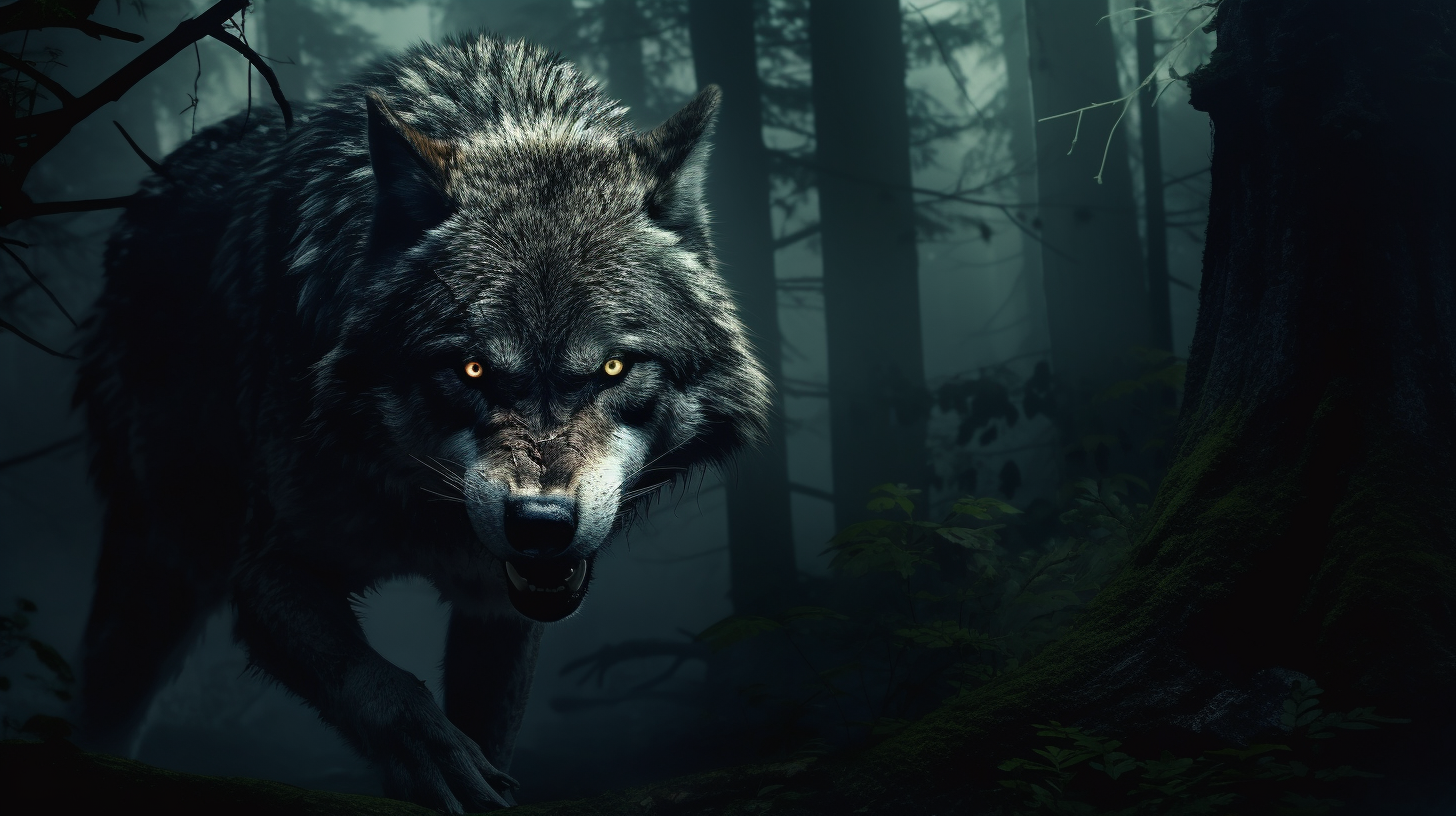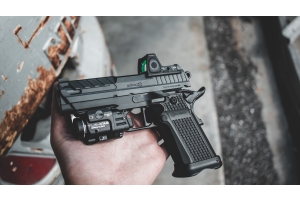Night Hunting: A Comprehensive Guide for Beginners
0%

Night Hunting: A Comprehensive Guide for Beginners
Night hunting has seen a surge in popularity in recent years. As technology advances and more data is collected about various animals, it has become an increasingly effective method for controlling nuisance animals and an enjoyable pastime. This comprehensive guide by Fusion Firearms is tailored to beginners who want to venture into the world of night hunting.
Understanding Night Hunting Laws
Before embarking on a night hunting adventure, it's crucial to be aware of your state's laws and regulations. Ignorance of the law is no excuse, so always stay up-to-date on the rules in your jurisdiction. While the specifics vary from state to state, some animals are more frequently hunted at night and often have fewer regulations. These typically include wild hogs, raccoons, and predators like coyotes, foxes, and bobcats.
The reason these animals are subject to fewer regulations is because they are often considered nuisances. Landowners and farmers frequently hunt these animals on their properties to control their populations and mitigate property damage. Understanding these regulations is essential for responsible night hunting.
Night Vision and Lighting
One of the most significant challenges in night hunting is visibility. Without proper visibility, it's impossible to shoot safely and accurately. There are two primary methods to address this issue: night vision or thermal devices, and the use of lights.
While night vision and thermal devices offer the most effective solution, they can be expensive. For those on a budget, using lights is a more affordable option. Surprisingly, many animals perceive light and colors differently than humans, and this has led to the development of lights in various colors and intensities specifically designed for night hunting. The choice of light color and intensity can significantly impact your success, and this guide will delve into this aspect in detail.
Night Hunting Methods
Once you've addressed visibility, you need to choose a method for locating and approaching the animal. This choice depends on several factors, including the season, location, and the type of animal you're hunting.
There are two primary methods for night hunting, which mirror those used during the day:
-
Hunting over Bait: Utilizing bait or natural food sources is a time-tested hunting strategy. While many jurisdictions regulate hunting over bait, it can be transferred to night hunting with some adaptations. Proper lighting is crucial when hunting over bait, and specific lights designed for feeders can be beneficial.
-
Using Callers: Using predator callers can be highly effective for hunting coyotes, foxes, bobcats, and hogs. However, animals tend to be more alert when responding to calls, making visibility even more critical. A light attachment on your rifle for taking the shot and a hand-held light for scanning the area can be invaluable.
Weapon Choices for Night Hunting
When it comes to selecting a weapon for night hunting, you can typically use any weapon that's legal for day hunting in your area. However, many dedicated night hunters prefer AR-style assault rifles for their versatility and the ability to add accessories like flashlight attachments and laser sights. These rifles are semi-automatic, allowing for multiple shots quickly, making them a preferred choice for hunting animals like wild hogs.
Advantages of Night Hunting
Night hunting offers unique advantages. Animals tend to be more active at night, especially those that are primarily nocturnal. Additionally, during the summer months, hunting at night can help you avoid the scorching daytime heat. While there are some challenges, such as increased snake activity, night hunting can be an exciting and rewarding experience.
Hunting Coyotes at Night
Coyote hunting has captured the fascination of many, whether pursued as a passionate pastime or a means of population control. Regardless of your motivation, delving into the thrilling world of hunting coyotes at night can be an exhilarating adventure, merging strategy, skill, and patience. In this comprehensive guide, we'll delve into the critical aspects of mastering the art of coyote hunting under the cover of darkness, ensuring you are well-prepared for a successful nocturnal pursuit.
Preparing for the Night Hunt
Scouting: Your Blueprint for Success
If you've made the decision to embark on a night hunting expedition, chances are you're already familiar with hunting in general. However, scouting remains a fundamental pillar of success, no matter your experience level. Gathering as much data as possible is the key to achieving your goals in the world of hunting, and night hunting is no exception.
Scouting serves a dual purpose when it comes to nighttime coyote hunting. Firstly, it enables you to identify the optimal location for your hunt, a place where coyotes are known to be active. Secondly, and perhaps more crucially, it enhances safety for both you and others involved in the hunt.
During the daytime scouting missions, look for signs of coyote activity in the area. Additionally, take note of potential locations to set up your hunting position when the night falls. Your choice of hunting spot should offer visibility within a reasonable distance, albeit not as extensive as what you'd require during daylight hunting.
The distance you can effectively cover at night largely depends on your equipment. Whether you're employing lights, night vision, or thermal optics, this factor significantly influences your effective shooting range. Furthermore, the weapon of your choice also plays a role; a rifle affords you a more extended shooting range compared to a shotgun or bow.
Another facet to consider when selecting your location is the exceptional night vision of coyotes themselves. These creatures possess keen night vision capabilities, so sometimes it pays off to position yourself in an area that doesn't provide excessive visibility. The principle of "it can't see me if I can't see it" may not hold true if you're in a well-lit, open field. Thus, choosing a visually less open area could prove strategic for your nighttime coyote hunt. However, remember that this decision interacts with various other factors, emphasizing the importance of thorough daytime scouting.
Beyond locating your ideal hunting spot, scouting in the daylight hours is paramount for safety. Familiarize yourself with the terrain when there's ample light, especially if you're in unfamiliar territory. Make a mental note of nearby houses or structures, as landscapes transform significantly in the dark. This awareness not only enhances safety but also minimizes the risk of getting lost in the wilderness.
Methods for Nocturnal Coyote Hunting
Coyote hunting at night offers a range of effective methods, each with its unique appeal and strategy. The most popular approach involves using various calls, but depending on local regulations and preferences, alternative methods like baiting or targeting heavily traveled trails can also yield impressive results.
Hunting Coyotes at Night Using Calls
Utilizing calls remains the cornerstone of nocturnal coyote hunting, and for a good reason. It stands as one of the most popular and effective methods to locate and lure coyotes into your sights. Calls come in various forms, each serving a specific purpose.
When it comes to mimicking prey animals in distress, like a rabbit, certain calls are designed explicitly for this task. Such calls send a clear signal to any nearby predators that an easy meal might be within reach, arousing their curiosity and drawing them closer to investigate.
However, don't limit yourself to just distress calls. Calls that replicate the vocalizations of other coyotes are equally vital in your gear arsenal. These calls establish a connection with coyotes, enticing them to respond or investigate. Knowing the types of calls to use and when to employ them is a skill that can significantly impact your success.
Suppose you've followed our recommendation of thorough daytime scouting. In that case, you'll already have a general idea of the areas frequented by coyotes. Head to your selected starting point, and take a moment to sit in silence. If you've ever ventured into the woods after dark, you've likely heard coyotes howling in the distance.
Being aware of coyotes' propensity to vocalize at night can provide a significant advantage. Not only does it indicate their presence, but it can also help pinpoint their location with remarkable accuracy. This knowledge guides you in choosing the perfect spot to initiate your calls, enabling you to adjust your position based on proximity and wind direction.
If silence persists, employ a call that mimics a coyote howl. This often prompts a response howl, revealing the coyotes' location. Howling also serves as an effective method for drawing coyotes directly to your position. Understanding the various howl types and their messages to coyotes is crucial; different howls convey different intentions. Refer to our recommendations for the best coyote howler calls for further details.
Once you've pinpointed the coyotes' whereabouts, consider using a howler call to entice them further. If this tactic proves ineffective or you prefer alternative methods, a predator call mimicking distressed prey can be equally effective.
Silence and stillness are your allies when calling and after. Coyotes will be on high alert when approaching, relying heavily on their acute senses of smell, sight, and hearing.
Hunting Coyotes at Night Without a Call
While calling remains a preferred method, it's by no means the only approach. Calling can be challenging in certain environments, like densely vegetated terrain or rolling hills, as it necessitates close proximity to your target. This proximity can increase the risk of being detected before you even have a chance to call. In such cases, alternative strategies are worth considering.
Coyote Hunting Over Bait at Night
Hunting over bait is a viable option, provided local regulations permit it. Start by scouting the area during daylight hours to identify spots where coyotes are likely to find the bait source. Set up the bait in a strategic location that allows you to remain concealed while ensuring visibility of your target area.
For rifle users, maintaining a reasonable distance from the bait source enhances your concealment. However, bear in mind the challenge of darkness; you must ensure visibility of your target. If you're investing in thermal or night vision optics, lighting concerns diminish. Nevertheless, effective lighting options are available for those seeking cost-effective solutions.
Explore our recommendations for top-quality lights, suitable for both scanning and shooting, to elevate your baited hunt.
Hunting on Trails
Coyotes, much like other wildlife, often follow established routes when moving from one area to another. Identifying these trails or old roads and staking out a strategic position along them can be a winning strategy, particularly when combined with calling. Daytime scouting offers the opportunity to inspect these trails for signs of coyote activity, such as feces.
Sitting on a trail can significantly complement your overall hunting strategy. Furthermore, it can serve as an effective approach when combined with calling, increasing your chances of a successful night hunt.
Spot and Stalk
In open spaces, such as vast fields, the spot and stalk method can be employed effectively. This strategy involves using various optics to scan the area from a distance, spotting coyotes from afar before slowly closing the gap for a well-placed shot.
The feasibility of this method hinges on the suitability of your firearm setup, your comfort with long-range shooting, and safety considerations. The ability to execute long-range shots safely and effectively is a prerequisite for this approach.
Other Methods
While less commonly employed, there are alternative methods for night coyote hunting without the use of calls. Group hunts, known as "drives," and even employing dogs can be considered. However, these methods tend to be challenging and, at times, unsafe during the night. Additionally, legal restrictions may prohibit the use of dogs in many jurisdictions, making them a less advisable choice.
Essential Gear for Nocturnal Coyote Hunting
Selecting the right gear is pivotal for a successful night hunt, as it significantly impacts your performance and safety. While this list is not exhaustive, it highlights key items to consider for your nocturnal coyote hunting expedition.
Lights: Illuminating the Darkness
Hunting in the dark necessitates a reliable source of light. While thermal and night vision optics are valuable, a dependable hand-held light is essential. Invest in a variety of lights, each with a designated purpose. These may include a hand-held light for scanning, a weapon-mounted light for shooting, and a blood tracking light.
Light color is a critical consideration, affecting your visibility and stealth. Refer to our article for detailed recommendations on suitable light types for night hunting and how to choose the ideal light color.
Thermal/Night Vision (Optional)
Although not obligatory, thermal or night vision optics can significantly enhance your hunting capabilities at night. These devices enable you to navigate the dark without the need for additional lighting, maintaining a higher level of stealth. Their utility, however, comes with pros and cons. Delve into our article on hunting wild hogs at night for an in-depth exploration of thermal and night vision optics and their applicability to coyote hunting.
Callers: Voice of the Hunter
Selecting the right callers is crucial, as they form the backbone of your night hunting strategy. Two primary categories of calls come into play: howler calls and distress calls.
Howler calls replicate the vocalizations of other coyotes, establishing a connection with the target. Distress calls mimic the sounds of distressed prey animals, grabbing the attention of nearby predators.
Whether you opt for a hand-held caller or an electronic one, ensure compliance with local regulations. Electric callers offer ease of use but may be subject to legal restrictions in certain areas. Always verify the governing regulations for your specific location.
Other Gear
Decoy
In open landscapes, such as fields, deploying a decoy can be advantageous. Placing a decoy strategically where you intend to call can pique a coyote's curiosity and draw it closer. Additionally, devices mimicking the movement of small distressed animals can complement distress calls effectively.
Camouflage
While the necessity of camouflage at night remains debated, it's a prudent measure to adopt. Camouflage helps break your outline and enhances concealment. Explore our dedicated article on the topic to make an informed decision regarding its use during your night hunts.
Game Camera
The relevance of a game camera depends on your chosen hunting method. If you're hunting over bait or along trails, a game camera offers valuable insights into the local coyote population and their visitation patterns. Opt for a camera with fast trigger speed and adjustable detection range for best results.
Advantages of Nocturnal Coyote Hunting
The night offers distinct advantages when pursuing coyotes. These creatures are predominantly nocturnal, exhibiting heightened activity levels under the cover of darkness. This natural behavior increases your odds of encountering them during your nighttime excursions.
Coyotes tend to be more vocal at night, making their presence known through distinctive howls. This vocalization provides a valuable auditory cue for hunters, aiding in pinpointing their locations. This advantage extends to nighttime hunters, granting them an edge over daytime counterparts.
Selecting the Ideal Weapon for Nighttime Hunts
The choice of weapon plays a pivotal role in the success of your night hunt. When selecting the ideal firearm, consider a range of factors, including local laws and regulations, to make an informed decision. Below, we outline the key factors to contemplate before venturing into the night.
Rifle: The Long-Range Advantage
A rifle stands as an exceptional choice for those seeking extended shooting ranges. If your hunting grounds feature open environments where shots beyond 100 yards are likely, a rifle is highly recommended. Several rifle calibers are ideal for coyote hunting, offering flat trajectories and minimal hide damage.
Popular options include the .223, 22-250, and .243 calibers, each well-suited for predator hunting. Paired with the right barrel length and quality optics, these calibers facilitate precise shots well beyond 400 yards.
Shotgun: Ideal for Close Encounters
Shotguns excel at close-range encounters, making them valuable for hunting on trails or near bait sources. While shotguns have the potential to damage a coyote's hide, the choice of ammunition can mitigate this issue. The 20 gauge shotgun caliber is a popular choice for predator hunting, offering versatility and effectiveness.
Bow: A Challenging Option
Bow hunting at night presents a unique challenge, requiring additional skill and precision. While it's a viable option, it demands expertise in both archery and nighttime hunting. Explore our article on setting up a bow for night hunting if you're prepared for this exhilarating endeavor.
In Conclusion
Mastering the art of coyote hunting at night involves a combination of knowledge, skill, and the right gear. Successful night hunts hinge on thorough scouting, effective calling strategies, and selecting the ideal weapon. Whether you prefer calling coyotes or employing alternative methods, the nocturnal pursuit offers unique advantages and thrilling challenges. Embrace the darkness, equip yourself with the right gear, and embark on a nocturnal adventure that promises excitement and the chance to become a skilled nocturnal marksman.
Final Thoughts
In conclusion, night hunting adds an exhilarating twist to the hunting experience. With the right equipment and knowledge of the regulations, it can be an effective method for controlling animal populations and a thrilling adventure. Fusion Firearms is committed to providing valuable information and resources to help both novice and experienced hunters make the most of their night hunting experiences. Happy hunting!
Disclaimer: This article is provided for informational purposes only. Always adhere to your local laws and regulations when engaging in night hunting activities.
About Fusion Firearms: Fusion Firearms is dedicated to providing hunters and outdoor enthusiasts with the best gear and information to enhance their experiences in the great outdoors. Our mission is to offer thorough and complete guidance to help you achieve your goals, whether you're a newcomer or a seasoned night hunter.





![wolf hunting at night]](https://fusionfirearms.com/media/wysiwyg/Wolf_2_.png)









